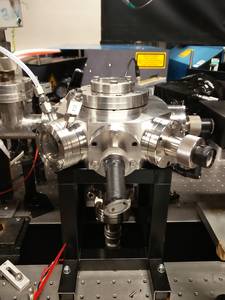Meteoric Ablation SImulation (MASI)
Middle/Upper Atmosphere Laboratory, Current Research.

The solar system is a dusty environment. Trillions of cosmic dust particles smaller than one millimetre in size have been left behind by comets and asteroids. They orbit the Sun forming a relatively dense cloud. If all these particles were compressed together into a single body, they would form a moon of 25 km in diameter. These particles consist of aggregates of magnesium, iron, sodium, calcium and aluminium silicates, iron-nickel sulfide and organic matter. They are representative of the composition of the primitive solar nebula, i.e. when the sun and the planets were forming. The Earth (and the other planets) sweeps up cosmic dust very effectively as it orbits the Sun. Approximately 50,000 kg of dust grains fall from space into the Earth’s atmosphere every day. Surprisingly, it is cosmic dust, and not normal meteorites, that contributes to the bulk of the extra-terrestrial material falling into Earth. Meteorites contribute less than 1% to the total incoming mass, except when a body larger than about 50 meters strikes (thankfully this does not happen very often). Cosmic dust particles melt or vaporize when they enter Earth’s atmosphere at high speed (11–72 km s−1 ) due to air friction. This depends on their speed, size, density and entry angle. Still, a sizeable fraction of them reach the surface. These micrometeorites are regularly collected from sea sediments, deserts and from snow and ice in the polar caps. High in the atmosphere, the evaporated material (mostly metal atoms) forms layers. These layers typically occur at around 90 km in altitude. They can be detected from the ground and from satellites. The fraction of the dust that evaporates rather than falling to Earth is not very well known. The material evaporated in the atmosphere has a variety of impacts:
• Sporadic ionized metal layers associated to meteor showers and auroral activity have a significant impact on radio communications, both by facilitating over-the-horizon high-frequency communication and by obscuring space-to-ground communications, depending on the time of day and transmission frequency.
• The iron and sodium metal layers are regularly monitored from the ground using a combination of high performance lasers and telescopes, and due to their high stability these observations allow the dynamics of the upper atmosphere to be studied.
• Meteoric metals react chemically with atmospheric constituents (oxygen, carbon dioxide, water) forming new molecules, which eventually re-condense forming particles called “meteoric smoke”.
• Meteoric smoke particles can help the formation of high clouds (so called ‘noctilucent’ clouds). As the Earth’s lower atmosphere warms due to climate change, the upper atmosphere cools. At the same time, the amount of water vapor also increases. This results in more formation of high level ice clouds. For this reason, these clouds are considered climate change indicators.
• As the meteoric smoke particles fall down the atmosphere, they affectstratospheric sulphate particles, which play a key role in Earth’s climate and in ozone depletion over the Polar Regions.
• The Fe deposited in the ocean surface is a potential fertilizer as it is readily available for uptake by phytoplankton.
• Elements of astro-biological relevance such as carbon, phosphorus and sulfur are deposited in the atmosphere or the Earth’s surface by cosmic dust, so it can potentially help answer the question “is there (or was there) extraterrestrial life?” and “how did life start on Earth?”.
• These metal layers also help us in our understanding of the atmospheres of other planets. Other planetary atmospheres of different composition (e.g. Venus, Mars, and Titan) are also affected by cosmic dust.
Our research in general focusses on one side on understanding how cosmic dust particles evaporate in the upper atmosphere and what fraction finally reaches the surface, and on the other, how the evaporated meteoric metals are processed in the atmosphere and what the impacts for atmospheric chemistry on Earth and other Solar System bodies are. We address these scientific questions using a combination of experimental and theoretical work. MASI simulates the heating that would be experienced by a cosmic dust particle as it enters the Earth’s atmosphere. To do this, we have to heat the particle rapidly to temperatures as high as 2600 °C (4700 °F) in a few seconds, then cool it back down again. This is the first time that such controlled flash-heating has been applied to meteorite samples. We measure the metal atoms that evaporate from the particle by a technique called Laser Induced Fluorescence (LIF). We can then compare this data with our predictions to test our ablation model.
Publications
Bones, et al., A novel instrument to measure differential ablation of meteorite samples and proxies: the Meteoric Ablation Simulator (MASI), Rev. Sci. Instr., 2016, 87, 094504, DOI:10.1063/1.49627
